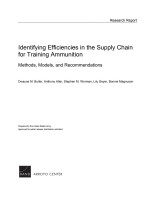| 来源类型 | Research Reports
|
| 规范类型 | 报告
|
| DOI | https://doi.org/10.7249/RR952
|
| 来源ID | RR-952-A
|
| Identifying Efficiencies in the Supply Chain for Training Ammunition: Methods, Models, and Recommendations |
| Dwayne M. Butler; Anthony Atler; Stephen M. Worman; Lily Geyer; Bonnie Magnuson-Skeels
|
| 发表日期 | 2016
|
| 出版年 | 2016
|
| 页码 | 80
|
| 语种 | 英语
|
| 结论 |
- Because enterprise metrics for ASP operations do not exist, RAND developed the RAND ASP Benchmarking Tool, which is capable of establishing performance baselines across ASPs. The tool uses data pulled from numerous sources and separates those data into structural- and activity-related characteristics of individual ASPs. It could also be used for trend analysis at one or more ASPs to assess performance over time.
- A case study of the Fort Hood ASP identified a number of innovative methods for tackling munitions management--related challenges and demonstrated use of the Benchmarking Tool.
- Forecasting of ammunition needed to support training requirements can never be exact; however, deficient procedures are leading to increased, unpredicted workload at ASPs.
- ASPs and the installations on which they reside tend to vary in how they operate across the following areas: operating procedures and safety; training and interface with customer units drawing ammunition; human capital management and equipment; and budgeting procedures. These variations significantly hamper the enterprise-level tracking of cost reductions.
- A number of USMC practices in training ammunition operations — for example, USMC's treatment of brass and residue following a unit's training event and several of its online automated information systems and publications — provide potentially significant areas in which the Army could gain efficiencies.
|
| 摘要 |
- Develop standardized metrics and critical information requirements for the ammunition community.
- Provide guidance and support to improve unit-level forecasting of ammunition required for training.
- Provide training to unit personnel who draw ammunition and hold them accountable for procedural discrepancies.
- Develop standard operating procedures (SOPs).
- Standardize the rules of allocation for personnel and equipment assigned to Ammunition Supply Points (ASPs) and Installation Ammunition Management Offices (IAMOs).
- Establish clearly defined position descriptions for ASP personnel and IAMOs.
- Seek improved methods for employing active and reserve duty ammunition soldiers.
- Address safety shortfalls.
- Improve knowledge sharing across the ammunition community.
- Investigate the potential for continuous inventory control to enhance inventory accountability.
- Consider reducing the residue and reconciliation burden on the ASPs.
|
| 主题 | Military Education and Training
; Military Equipment
; Supply Chain Management
; United States Army
|
| URL | https://www.rand.org/pubs/research_reports/RR952.html
|
| 来源智库 | RAND Corporation (United States)
|
| 引用统计 |
|
| 资源类型 | 智库出版物
|
| 条目标识符 | http://119.78.100.153/handle/2XGU8XDN/108347
|
推荐引用方式
GB/T 7714 |
Dwayne M. Butler,Anthony Atler,Stephen M. Worman,et al. Identifying Efficiencies in the Supply Chain for Training Ammunition: Methods, Models, and Recommendations. 2016.
|
|
文件名:
|
x1495316325097.jpg
|
|
格式:
|
JPEG
|

|
文件名:
|
RAND_RR952.pdf
|
|
格式:
|
Adobe PDF
|
除非特别说明,本系统中所有内容都受版权保护,并保留所有权利。